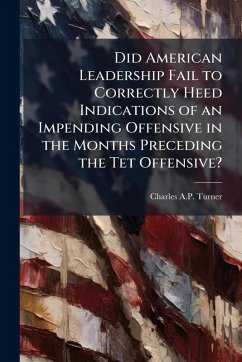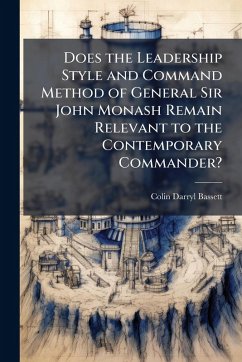
Comparative Analysis of the Military Leadership Styles of Ernest J. King and Chester W. Nimit
Versandkostenfrei!
Versandfertig in über 4 Wochen
15,99 €
inkl. MwSt.
Weitere Ausgaben:

PAYBACK Punkte
8 °P sammeln!
In a constantly changing world threatened by the likelihood of terrorist acts, the American people need military leaders who clearly demonstrate an understanding of American core values, and who are both competent and morally focused. In order to produce military leaders who meet these qualifications and who can successfully meet the future challenges America faces, it is important to develop and refine those leaders early and help them understand how to create and refine a successful leadership style. The process of developing leadership styles, however, is not easy and it requires a prodigio...
In a constantly changing world threatened by the likelihood of terrorist acts, the American people need military leaders who clearly demonstrate an understanding of American core values, and who are both competent and morally focused. In order to produce military leaders who meet these qualifications and who can successfully meet the future challenges America faces, it is important to develop and refine those leaders early and help them understand how to create and refine a successful leadership style. The process of developing leadership styles, however, is not easy and it requires a prodigious amount of determination, time, and planning from prospective future leaders. It also requires military training institutions to align their curriculums to promote leadership, as well as, to provide guidance and mentoring in order to help develop these future leaders. One way to help develop leaders is to provide examples of both successful and flawed military leadership styles. There are many cases of each in American history. In particular, World War II leaders Admirals Ernest J. King and Chester W. Nimitz provide contrasting examples of naval leadership. An examination of the leadership styles of these two naval officers provides useful examples which future leaders can consider when reflecting on their own leadership styles. After careful review, it soon becomes evident that the leadership style of Nimitz closely aligned with the leadership styles of Generals George C. Marshall and Dwight D. Eisenhower, two World War II leaders I closely examined in my previous Master's thesis. In addition, it also becomes evident that King was a diametrically different leader from these three leaders. He provides an example of a leader who was cold, harsh, and morally bankrupt. As result, reviewing the leadership styles of these World War II leaders will benefit future leaders as well as those they lead. This work has been selected by scholars as being culturally important, and is part of the knowledge base of civilization as we know it. This work was reproduced from the original artifact, and remains as true to the original work as possible. Therefore, you will see the original copyright references, library stamps (as most of these works have been housed in our most important libraries around the world), and other notations in the work. This work is in the public domain in the United States of America, and possibly other nations. Within the United States, you may freely copy and distribute this work, as no entity (individual or corporate) has a copyright on the body of the work. As a reproduction of a historical artifact, this work may contain missing or blurred pages, poor pictures, errant marks, etc. Scholars believe, and we concur, that this work is important enough to be preserved, reproduced, and made generally available to the public. We appreciate your support of the preservation process, and thank you for being an important part of keeping this knowledge alive and relevant.












